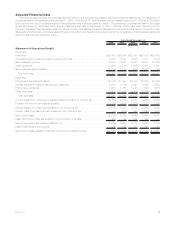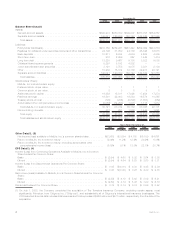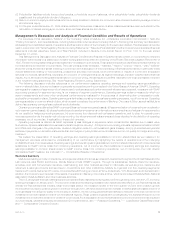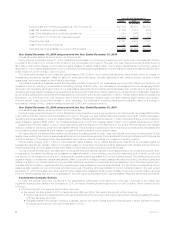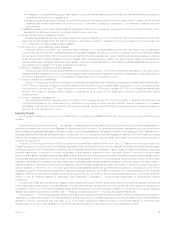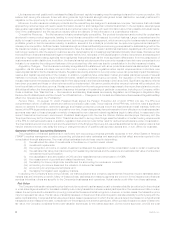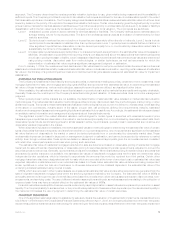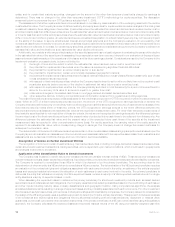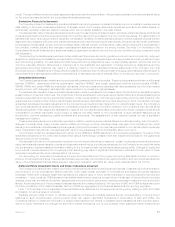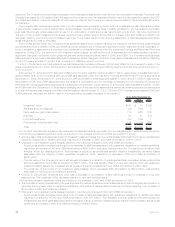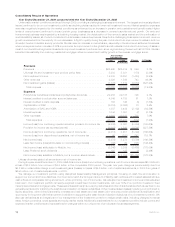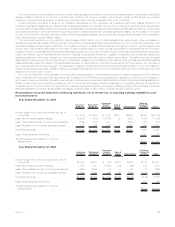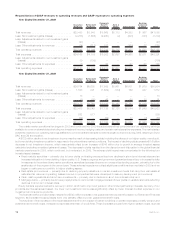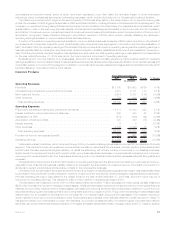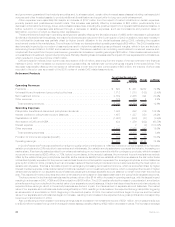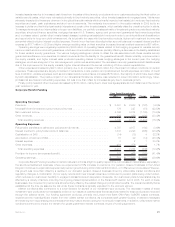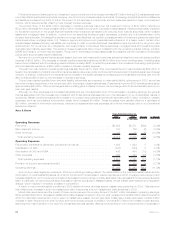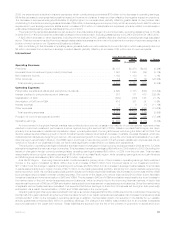MetLife 2009 Annual Report Download - page 19
Download and view the complete annual report
Please find page 19 of the 2009 MetLife annual report below. You can navigate through the pages in the report by either clicking on the pages listed below, or by using the keyword search tool below to find specific information within the annual report.– The widening of the Company’s own credit spreads decreased the valuation of guarantee liabilities, increased actual gross profits and
increased DAC and VOBA amortization by $739 million. This was partially offset by higher risk margins which increased the guarantee
liability valuations, decreased actual gross profits and decreased DAC and VOBA amortization by $100 million.
– Reductions in both actual and expected cumulative earnings of the closed block resulting from recent experience in the closed block
combined with changes in expected dividend scales resulted in an increase in closed block DAC amortization of $195 million,
$175 million of which was related to net investment gains (losses).
– The remainder of the impact of net investment gains (losses), which increased DAC amortization by $129 million, was attributable to
numerous immaterial items.
• Increases in amortization in 2008 resulting from changes in assumptions related to in-force/persistency of $159 million were driven by
higher than anticipated mortality and lower than anticipated premium persistency during 2008.
The Company’s DAC and VOBA balance is also impacted by unrealized investment gains (losses) and the amount of amortization which
would have been recognized if such gains and losses had been recognized. The significant decrease in unrealized investment losses
decreased the DAC and VOBA balance by $2.8 billion in 2009 whereas increases in unrealized investment losses increased the DAC and
VOBA balance by $3.4 billion in 2008. Notes 3 and 6 of the Notes to the Consolidated Financial Statements include the DAC and VOBA offset
to unrealized investment losses.
Goodwill
Goodwill is the excess of cost over the estimated fair value of net assets acquired. Goodwill is not amortized but is tested for impairment at
least annually or more frequently if events or circumstances, such as adverse changes in the business climate, indicate that there may be
justification for conducting an interim test. We perform our annual goodwill impairment testing during the third quarter of each year based upon
data as of the close of the second quarter.
Impairment testing is performed using the fair value approach, which requires the use of estimates and judgment, at the “reporting unit”
level. A reporting unit is the operating segment or a business one level below the operating segment, if discrete financial information is
prepared and regularly reviewed by management at that level. For purposes of goodwill impairment testing, a significant portion of goodwill
within Banking, Corporate & Other is allocated to reporting units within our business segments.
For purposes of goodwill impairment testing, if the carrying value of a reporting unit exceeds its estimated fair value, there might be an
indication of impairment. In such instances, the implied fair value of the goodwill is determined in the same manner as the amount of goodwill
would be determined in a business acquisition. The excess of the carrying value of goodwill over the implied fair value of goodwill is
recognized as an impairment and recorded as a charge against net income.
In performing our goodwill impairment tests, when we believe meaningful comparable market data are available, the estimated fair values
of the reporting units are determined using a market multiple approach. When relevant comparables are not available, we use a discounted
cash flow model. For reporting units which are particularly sensitive to market assumptions, such as the retirement products and individual life
reporting units, we may corroborate our estimated fair values by using additional valuation methodologies.
The key inputs, judgments and assumptions necessary in determining estimated fair value include projected operating earnings, current
book value (with and without accumulated other comprehensive income), the level of economic capital required to support the mix of
business, long term growth rates, comparative market multiples, the account value of in-force business, projections of new and renewal
business, as well as margins on such business, the level of interest rates, credit spreads, equity market levels, and the discount rate we
believe appropriate to the risk associated with the respective reporting unit. The estimated fair value of the retirement products and individual
life reporting units are particularly sensitive to the equity market levels.
When testing goodwill for impairment, we also consider our market capitalization in relation to our book value. We believe that our current
market capitalization supports the value of the underlying reporting units.
We apply significant judgment when determining the estimated fair value of our reporting units and when assessing the relationship of
market capitalization to the estimated fair value of our reporting units and their book value. The valuation methodologies utilized are subject to
key judgments and assumptions that are sensitive to change. Estimates of fair value are inherently uncertain and represent only
management’s reasonable expectation regarding future developments. These estimates and the judgments and assumptions upon which
the estimates are based will, in all likelihood, differ in some respects from actual future results. Declines in the estimated fair value of our
reporting units could result in goodwill impairments in future periods which could materially adversely affect our results of operations or
financial position.
During our 2009 impairment tests of goodwill, we concluded that the fair values of all reporting units were in excess of their carrying values
and, therefore, goodwill was not impaired. However, we continue to evaluate current market conditions that may affect the estimated fair value
of our reporting units to assess whether any goodwill impairment exists. Deteriorating or adverse market conditions for certain reporting units
may have a significant impact on the estimated fair value of these reporting units and could result in future impairments of goodwill. See Note 7
of the Notes to the Consolidated Financial Statements for further consideration of goodwill impairment testing during 2009.
Liability for Future Policy Benefits
The Company establishes liabilities for amounts payable under insurance policies, including traditional life insurance, traditional annuities
and non-medical health insurance. Generally, amounts are payable over an extended period of time and related liabilities are calculated as the
present value of future expected benefits to be paid reduced by the present value of future expected premiums. Such liabilities are
established based on methods and underlying assumptions in accordance with GAAP and applicable actuarial standards. Principal
assumptions used in the establishment of liabilities for future policy benefits are mortality, morbidity, policy lapse, renewal, retirement,
disability incidence, disability terminations, investment returns, inflation, expenses and other contingent events as appropriate to the
respective product type. These assumptions are established at the time the policy is issued and are intended to estimate the experience for
the period the policy benefits are payable. Utilizing these assumptions, liabilities are established on a block of business basis. If experience is
less favorable than assumptions, additional liabilities may be required, resulting in a charge to policyholder benefits and claims.
Future policy benefit liabilities for disabled lives are estimated using the present value of benefits method and experience assumptions as
to claim terminations, expenses and interest.
Liabilities for unpaid claims and claim expenses for property and casualty insurance are included in future policyholder benefits and
represent the amount estimated for claims that have been reported but not settled and claims incurred but not reported. Other policyholder
13MetLife, Inc.


